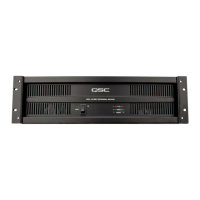Technical Service Manual 17
ISA Series Power Amplifiers
When first checking the operation of an amplifier on the bench,
always turn your variable transformer down to zero before
plugging the amplifier in. After you turn the amplifier on, gradually
turn up the AC voltage as you observe the amplifier’s behavior and
its current draw; this will help you determine what, if anything, is
wrong with it. If you see or smell smoke, flames, or any other signs
of short circuits or excessive current draw, quickly turn the AC back
down to zero. If no such problems occur, it is usually safe to turn
the AC up to the amplifier’s full operating voltage for further
testing.
Moderate increase in current draw (current increases
slowly, doesn’t become excessive until about ¼ of the
amplifier’s full AC operating voltage)
• One polarity’s drivers and/or power transistors (NPN
or
PNP) is
shorted, on one or both channels.
• Individual supply clamp diodes D117, D118, D217, or D218 is
reversed or shorted.
• Bias diodes D108, D109, D208, or D209 or bias trimpots R131 or
R231 is open.
Slow increase in current draw (current doesn’t become
excessive until about half of the amplifier’s full AC
operating voltage; amplifier may pass signal)
• The bias is severely misadjusted, or bias diodes D108, D109,
D208, or D209 is defective.
• An oscillation is causing excessive current demand.
Runaway current draw (current increases sharply at about
25 to 33% of the amplifier’s full AC operating voltage)
One or more reservoir capacitors is reversed. CAUTION: the gas
buildup in a reversed electrolytic capacitor can cause it
to vent explosively. Immediately turn off power and let the
capacitor cool down before replacing it.
3. Troubleshooting: Symptoms, causes, & remedies
3.1 Excessive current draw
The customer complains of blowing circuit breakers or fuses, or
burning smell or smoke.
Symptoms covered:
• Fuses blow immediately
• The amplifier quickly gets very hot
• Line circuit breakers trip at turn-on
• The amplifier hums loudly and the chassis vibrates
• The amplifier emits smoke
• The amplifier gives off a burning smell
If the symptoms indicate a possible problem in the channel circuits
or output sections, you can isolate either channel module from the
power supply by pulling its fuses from the AC board.
Possible situations:
Excessive current with no signal present
If the amplifier seems to run hot and draws higher-than-normal
current when idling at full AC voltage, the cause could be bias
misadjustments in the output circuitry of one or both channels. See
the calibration procedures in the next section.
Fast increase in current draw (current increases rapidly at
only a few volts AC)
• The main bridge rectifiers BR100 and/or BR200 (all models) and
BR101 and/or BR201 (ISA750 and ISA800Ti) is reversed or
shorted.
• Supply clamp diode pairs D117 and D118 and/or D217 and D218
is reversed or shorted.
• The drivers and/or power transistors is shorted on both
polarities (NPN
and
PNP) on one or both channels.
3.2 Protection, muting, and turn-
on/turn-off delay problems
The customer complains of amplifier locking up, or not turning on
and off correctly.
Symptoms covered:
• Both channels do not come out of protect
• Amplifier will not thermally shut down when it should
• Power LED doesn’t light
• Too little or too much muting delay
• No clip limiting
• Fan doesn’t run, or runs always at high speed
Possible situations:
Both channels stay in protect after turn-on
• Q4 or Q5 is shorted base-to-emitter.
• Voltage across D8 should be 14 to 15 volts DC. If it is low, check
D8 and R10; also, C7 and C8 is leaky.
• D9, R4, and/or R7 is open.
The amplifier will not thermally shut down when it over-
heats
Check for shorted D9, R4, or R7; check also for open LD1 (“POWER”
LED), R2, or R5.

